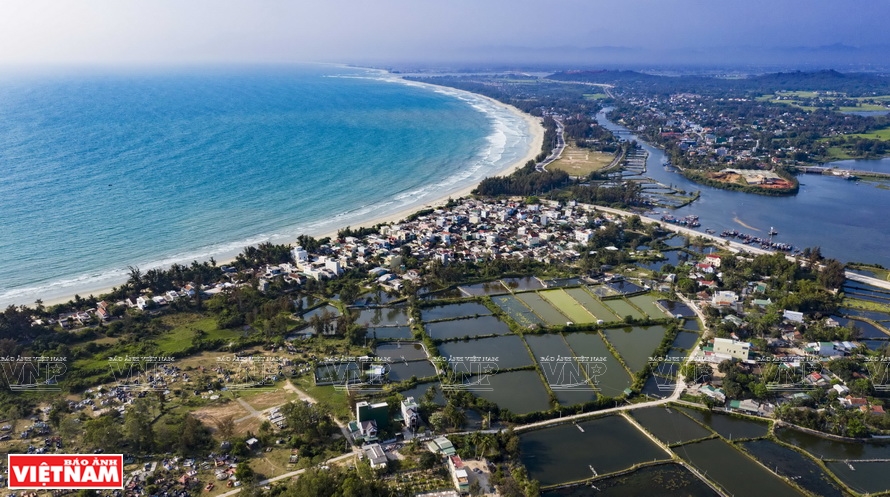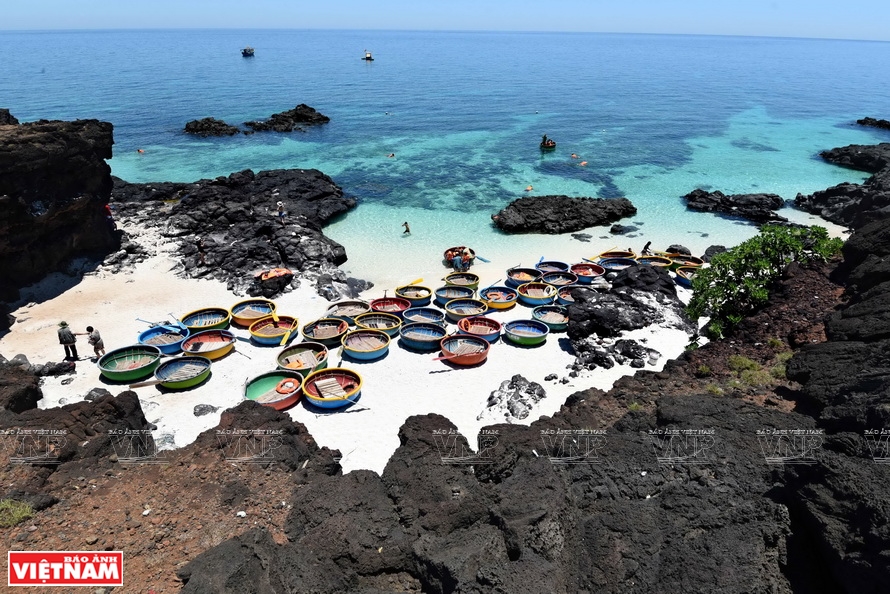Tra Khuc, the largest river in Quang Ngai, originates from 2,350m high Dac To Ron mountain before merging with the Rhe, Xa Lo (or Dak Xa Lo), Rinh (or Dak Drinh) and Tang rivers. The river runs to the east through Son Ha, Son Tinh and Tu Nghia districts and Quang Ngai city, then enters the sea through Dai Co Luy estuary. The river offers spectacular views while running through Quang Ngai where Thien An mountain looms silently by the river.
Along the Tra Khuc river is beautiful natural scenery, including four of Quang Ngai’s 12 natural wonders. They are Thien An Niem Ha (Thien An mountain – heavenly seal stamped on the river), Long Dau Hy Thuy (Long Dau mountain – dragon head playing with water), Ha Nhai Van Do (Ha Nhai wharf in sunset), and Co Luy village. Viewed from Thien An mountain, there are also many other picturesque places such as Thien But Phe Van (Thien But mountain-heavenly pen writing on cloud), Thach Bich Ta Duong (Thach Bich mountain in sunset glow), Thach Ky Dieu Tau (old man fishing on a cliff) reef, and An Hai sandbar.
 Overview of My Khe beach where the Tra Khuc river flows into the sea. Photo: Nguyen Dang Lam
The Son My memorial inside Son My relic site in Tinh Khe commune. Photo: Nguyen Dang Lam
 The traditional boat racing festival on the Tra Khuc river in Tinh Long commune. Photo: Nguyen Dang Lam
Co Luy boat building cooperative. Photo: Nguyen Dang Lam
 Khao le the linh Hoang Sa festival (the Feast and Commemoration Festival for Hoang Sa soldiers) in An Vinh commune, Ly Son island district. Photo: Nguyen Dang Lam
A Ba trao performance in Sa Huynh, Duc Pho district. Photo: Nguyen Dang Lam

Dried seafood processing in Sa Huynh, Duc Pho district. Photo: Nguyen Dang Lam
Cultivating garlic and onions in Ly Son. Photo: Nguyen Dang Lam
Basket boats for seeing coral in An Binh commune, Ly Son district. Photo: Nguyen Dang Lam
|
| Tra Khuc and Thien An have become an iconic pair of river and mountain in Quang Ngai, the image of which was carved in cuu dinh under the reign of King Minh Mang (1835). Cuu dinh are nine bronze urns each of which symbolizes a dynasty of Nguyen Kings. The top of each urn is carved with 17 patterns and a calligraphic drawing, featuring mountains, rivers and other scenery of unified Vietnam during the Nguyen reign. |
The Tra Khuc river has formed waterway trade and created a sub-region of Tra Khuc river culture, which covers a large area with widespread influence across Quang Ngai. This enriches the province’s unique culture with a huge treasure of folk songs and verses featuring the life of local farmers and traders.
Along the Tra Khuc river are popular craft villages, which include a blacksmithing village in Tinh Minh commune, Son Tinh district; a beansprouts village in Van hamlet, Son Tinh; Sung Tich and Thanh Kiet vegetable villages in Son Tinh and Tu Nghia districts; a flower village in Nghia Ha commune, Nghia Hoa district and North and South Co Luy welcome mat villages in Son Tinh and Tu Nghia. The area is also known nationwide for making rock sugar, cube sugar and coarse cane sugar.
On the banks of the Tra Khuc river are wharfs where boats can stop overnight and their owners can make barter for goods. Next to the river wharfs are stages for hat ho responsive singing and bai choi folk singing, usually organized during full moon nights, the lunar new year festival (Tet) and other festive events.
Viewed from the Co Luy village citadel is the immense area of Ly Son – Sa Huynh geopark and further away is green Ly Son island, the native land of the Hoang Sa (Paracel) flotilla. Ly Son island, regarded as Vietnam’s Maldives, is expected to promote tourism in Quang Ngai.
Industrial development downstream of the Tra Khuc river
The river, which brings alluvium from the peak of Dac To Ron mountain, runs 135 km through mountain and midland areas before entering the sea at Co Luy in Tu Nghia district. At the end of the river, an industrial triangle has been formed in Son Tinh and Binh Son districts and Quang Ngai city and is one of the leading industrial hubs in central Vietnam.
| Dung Quat economic zone in Ly Son island district is forming a development triangle along the Tra Khuc river, which is a lever creating links for economic development in Quang Ngai. |
In 1997, the Prime Minister decided to set up in Binh Son district the Dung Quat economic zone, the core of which is Dung Quat oil refinery, marking an important point in the province’s industrial development. Since its operation in early 2009, Dung Quat oil refinery has processed nearly 70 million tons of crude oil, supplying the market with around 65 million tons of products. The refinery, which made a profit of nearly 1 billion US dollars, has helped raise Quang Ngai’s industrial production remarkably, and paid taxes totaling 7.5 billion US dollars, making up around 70-80% of the province’s tax revenues. Dung Quat oil refinery is also a key project which has helped boost industrial activities in the Dung Quat economic zone.
In 2013, another important project, Vietnam-Singapore Industrial Park (VSIP), broke ground in the area downstream of the Tra Khuc river. The ceremony was witnessed by the prime ministers of the two countries. Receiving incentives and support from local authorities, VSIP Quang Ngai has readied in the first phase, 360 ha of infrastructure for investors. The industrial park has, to date, attracted 25 foreign direct investments (FDI) with a total registered capital of nearly 821 million US dollars. In 2018 alone, the park drew investments worth over 350 million US dollars, accounting for over 90% of the total FDI capital in Quang Ngai. In addition to investors from Taiwan, the Philippines, Singapore, Hong Kong, the US, South Korea and Japan, VSIP Quang Ngai attracted many European investors, proving that Quang Ngai is an attractive destination for both domestic and foreign investors.
 Maintenance process of oil pipelines at Dung Quat Refinery. Photo: Nguyen Dang Lam
Production line of Thach Bich products in Quang Ngai. Photo: Nguyen Dang Lam
Vietnamese workers perform all stages of equipment production at Doosan Vina. Photo: Nguyen Dang Lam
|
VSIP’s success has opened a new direction for industrial development in the province toward restructuring labor forces from agricultural to industrial production. VSIP has created 7,000 jobs and is expected to generate an additional 35,000 permanent jobs for locals once 25 projects are put into operation. Dung Quat economic zone and other industrial parks in Quang Ngai have also created nearly 52,000 jobs.
Dung Quat oil refinery and VSIP have become the nucleus for bringing industrial projects to Quang Ngai.
The projects located in the area where the Tra Khuc river enters the sea has opened up opportunities and created a foundation for Quang Ngai to become a modern industrial province







